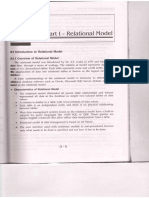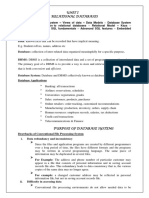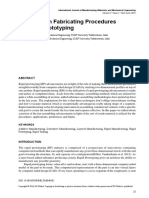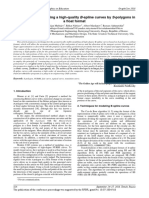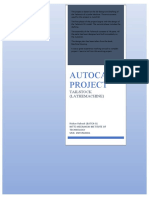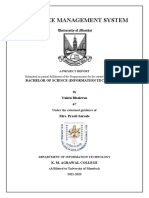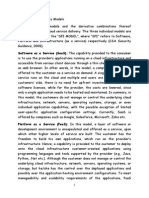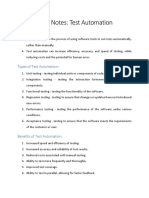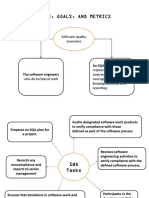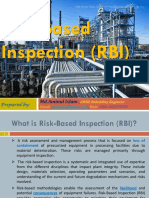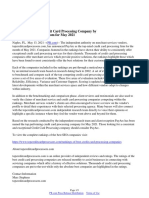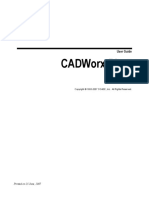Professional Documents
Culture Documents
Injection Molding From 3d Printed Molds
Injection Molding From 3d Printed Molds
Uploaded by
Damien WayneOriginal Description:
Original Title
Copyright
Available Formats
Share this document
Did you find this document useful?
Is this content inappropriate?
Report this DocumentCopyright:
Available Formats
Injection Molding From 3d Printed Molds
Injection Molding From 3d Printed Molds
Uploaded by
Damien WayneCopyright:
Available Formats
WHITE PAPER
Low-Volume Rapid Injection
Molding With 3D Printed Molds
This white paper provides methods and guidelines for using stereolithography (SLA) 3D printed
molds in the injection molding process to lower costs and lead time. Through the real-life
case studies with Braskem, Holimaker, and Novus Applications, you’ll learn how this hybrid
manufacturing process enables on-demand mold fabrication to quickly produce small batches of
thermoplastic parts.
December 2020 | formlabs.com
Inhalt
Introduction . . . . . . . . . . . . . . . . . . . . . . . . . . . . . . . . . . . . . . . . . . . . . . . . . . . . . 3
Method . . . . . . . . . . . . . . . . . . . . . . . . . . . . . . . . . . . . . . . . . . . . . . . . . . . . . . . . . 5
Process Workflow. . . . . . . . . . . . . . . . . . . . . . . . . . . . . . . . . . . . . . . . . . . . . . . 5
Design Guidelines . . . . . . . . . . . . . . . . . . . . . . . . . . . . . . . . . . . . . . . . . . . . . . 6
Other Best Practices. . . . . . . . . . . . . . . . . . . . . . . . . . . . . . . . . . . . . . . . . . . . . 7
Case Studies . . . . . . . . . . . . . . . . . . . . . . . . . . . . . . . . . . . . . . . . . . . . . . . . . . . . 8
Braskem Fabricated 3000 Mask Straps in a
Week With a High Temp Resin Mold Insert. . . . . . . . . . . . . . . . . . . . . . . . . . . 8
Holimaker Produces 100s of Technical Parts With Grey Pro Molds . . . . . . . . 12
Novus Applications Inject Molded Hundreds of
Threaded Caps With a Rigid 10K Three-Parts Mold . . . . . . . . . . . . . . . . . . . . 16
Conclusion . . . . . . . . . . . . . . . . . . . . . . . . . . . . . . . . . . . . . . . . . . . . . . . . . . . . . 22
FORMLABS: Low-Volume Rapid Injection Molding With 3D Printed Molds 2
Einführung
INJECTION MOLDING
Injection molding is one of the leading processes for manufacturing plastics. It is widely used
for mass-producing identical parts with tight tolerances. It is a cost-effective and extremely
repeatable technology that yields high-quality parts for large series. It can produce volumes from
1,000 to 100,000+ of parts at very low unit costs. Injection molding has a short cycle time, with
each machine capable of building new parts every 15 to 60 seconds. It is a fast, intensive process
where high heat and pressure are involved to melt thermoplastic and force it inside a mold.
Because of these extreme molding conditions, the tools are traditionally made out of metal by
CNC machining or electric discharge machining (EDM). These are expensive industrial methods
that require specialized equipment, high-end software, and skilled labor. As a result, the
production of a metal mold typically takes four to eight weeks, and costs anywhere from $2,000
to $100,000+ depending on the shape and the complexity of the part. Due to these high costs,
manufacturers are looking at ways to minimize the cost of custom tool production and reduce
lead times to bring products to the market faster.
Desktop 3D printing is a powerful solution to fabricate injection molds rapidly and at low cost. It
requires very limited equipment, saving CNC time and skilled operators for other high-value tasks
in the meantime. Manufacturers can benefit from the speed and flexibility of in-house 3D printing
to create the mold and couple it with the production force of injection molding to deliver a series
of units from common thermoplastics in a matter of days. They can even achieve complicated
mold shapes that would be difficult to manufacture traditionally, enabling development teams to
be more innovative. Furthemore, product development benefits from the ability to iterate on the
design before investing in hard tooling.
Even though 3D printing molds can offer these advantages when used appropriately, there are
still some limitations. We should not expect the same performance from a 3D printing polymer
mold as from a machined metallic one. Critical dimensions are harder to meet, cooling time is
longer because the thermal transfer occurs slower in plastic, and printed molds can easily break
under heat and pressure. However, some companies managed to produce series of hundreds of
parts with printed molds and even thousands of shots for very simple designs. Low-run injection
molds are great assets for engineers to deliver limited batches of end-use parts or prototypes in
the final plastic, for pre-production tests.
FAST FABRICATION OF SHORT-RUN INJECTION MOLDS
Stereolithography (SLA) printing technology is a great choice for molding. It is characterized by a
smooth surface finish and high precision that the mold will transfer to the final part and that also
facilitates demolding. 3D prints produced by SLA are chemically bonded such that they are fully
dense and isotropic, producing functional molds at a quality not possible with fused deposition
modeling (FDM). Desktop SLA printers, like those offered by Formlabs, simplify workflow as they
are easy to implement, operate, and maintain.
FORMLABS: Low-Volume Rapid Injection Molding With 3D Printed Molds 3
To support short-run injection molding, Formlabs developed High Temp Resin, which has a heat
deflection temperature (HDT) of 238°C @ 0.45 MPa, the highest among Formlabs resin and
one of the highest among resins on the market. High Temp Resin can withstand high molding
temperatures and minimize cooling time. This report will go through a case study with Braskem,
a company that ran 1,500 injection cycles with one mold insert printed with High Temp Resin
to produce mask straps. The company printed the insert and placed it inside a generic metallic
mold integrated in the injection system. This is a powerful solution to produce medium series
quickly. The printed insert can be replaced as the design evolves and in case of failure. It allows
for creating molds on-demand with elaborate geometries that would be difficult to manufacture
traditionally while still running multiple shots.
High Temp Resin, however, is quite brittle. In the case of more intricate shapes, it warps or cracks
easily. For some models, reaching more than a dozen cycles can be challenging. To solve this
challenge, French startup Holimaker turned to Grey Pro Resin. It has a lower thermal conductivity
than High Temp Resin, which leads to a longer cooling time, but it is softer and can wear
hundreds of cycles.
Formlabs recently released Rigid 10K Resin, an industrial-grade, highly glass-filled material,
which provides a solution that can cope with a wider variety of geometries and injection molding
processes. Rigid 10K has an HDT of 218°C @ 0.45 MPa and a tensile modulus of 10,000 MPa,
making it strong, extremely stiff, and thermally stable. Novus Applications has injected hundreds
of intricately threaded caps with a single Rigid 10K Resin mold. As more companies get their
hands on Rigid 10K Resin we expect it to be an excellent asset to print sophisticated molds for
injection molding.
This white paper will first give a general overview of the workflow, design guidelines, and best
practices for 3D printing molds for injection molding. Then, it will go into the details by covering
three case studies on how each firm found success with their 3D printed mold.
FORMLABS: Low-Volume Rapid Injection Molding With 3D Printed Molds 4
Method
PROCESS WORKFLOW
INJECTION MOLDING PROCESS WITH 3D PRINTED MOLDS
1 3 5
4 6
1 Design the mold 2 3D print the mold 3 Mold clamping 4 Inject 5 Cooling 6 Demold
Common problems encountered with 3D printed molds are:
• Dimensional accuracy of the mold: it is important to take into account that the dimensional
accuracy of a 3D printed mold is not as good as in a metallic machined mold. However, post-
processing the prints will bring size variations closer to the ones of a machined mold.
• Breakage or cracking of the mold under pressure and heat.
• Cycle time: the cooling time is longer than with a metallic mold as the thermal transfer occurs
slower in plastic parts.
• Demolding process:
• Adhesion of the part to the mold can cause deterioration of the mold during extraction.
• Flashing may occur and slow down the demolding step. This is an excess of material coming
out of the mold during the injection when the mold is overfilled, or if the parting plane is
not perfectly flat.
These issues can be mitigated by reducing the injection pressure, adapting the CAD file, and the
demolding process. These three parameters will largely influence the success of the operation.
The complexity of the injection molding process is mostly driven by the complexity of the part and the
mold structure. A broad range of thermoplastics can be injected with 3D printed molds such as PP, PE,
TPE, TPU, POM, or PA. A low viscosity material will help reduce the pressure and extend the lifetime of
the mold. Polypropylene and TPEs plastics are easy to process at a high amount of cycles. In contrast,
more technical plastics like PA will allow a lower number of runs. The handling of a release agent
helps to separate the part from the mold, in particular for flexible materials such as TPUs or TPEs.
The type of injection press does not have a significant influence on the process. If you are new to
injection molding and are looking into testing it with limited investment, using a benchtop injection
molding machine such as the Holipress or the Galomb Model-B100 could be a good option.
Desktop automated molders such as the product line from Babyplast are good alternatives for
mass production of small parts.
FORMLABS: Low-Volume Rapid Injection Molding With 3D Printed Molds 5
DESIGN GUIDELINES
We recommend respecting the rules of design for additive manufacturing as well as the general
rules for injection mold design, such as including two or five degrees of draft angles, maintaining
a uniform wall thickness across the part or rounding up the edges. Here are a few helpful advice
from users and experts, specific to polymer printed molds:
To optimize dimensional accuracy:
• Plan stock allowance on the mold to post-process and adjust sizes.
• Print one set of mold to understand dimensional deviations and account for this in the CAD
model of the mold.
3
5
Front of the mold Back of the mold
To extend the lifetime of the mold:
1. Open up the gate to reduce the pressure inside the cavity.
2. When possible, design one side of the stack flat while the other side carries the design. This will
lessen chances of blocks misalignment and risk of flashing.
3. Include large air vents from the edge of the cavity to the edge of the mold to allow the air to
escape. This yields a better flow into the mold, minimizes pressure and alleviates flashing in the
gate area to decrease cycle time.
4. Avoid thin cross-sections: surface thickness less than 1-2 mm may deform with heat.
To optimize the print:
5. Adjust the back of the mold to minimize material: reduce the cross section in areas that are not
supporting the cavity. It will save costs in resin and diminish risks of print failure or warpage.
6. Add chamfer to help to remove the piece from the build platform.
7. Add centering pins at the corners to align both prints.
FORMLABS: Low-Volume Rapid Injection Molding With 3D Printed Molds 6
OTHER BEST PRACTICES
To optimize dimensional accuracy:
• Print molds flat, directly on the build platform without support to reduce warpage whenever
possible. Skipping supports also saves printing time, labor, and resin.
• Select a base surface that will minimize overhangs.
• If your design does require support, avoid contact on molding faces to improve
surface quality.
• Post-process the printed mold: desktop milling or hand-sanding will help to fit both halves of
the mold together and avoid flashing.
To extend the lifetime of the mold:
• Keep the injection pressure and speed low.
• Support all free-hanging cores, in particular small diameter cores.
• Place the printed mold inside a metallic frame or print the insert and machine the outside of
the mold to provide support against the downward pressure and heat of the injection nozzle.
Standard aluminium frames are readily available from injection molder manufacturers. Another
option could be to use a metallic modular mold base system, such as the Master Unit Die
Quick-Change or similar solutions, allowing to quickly switch and replace printed mold inserts.
To facilitate the demolding process and reduce cycle time:
• Employ interchangeable stacks to run new cycles while the other sets cool in order
to decrease the cooling time, which compensates for the low thermal-conductivity of
a plastic mold.
• Cooling can be accelerated by applying compressed air to cool the mold.
• Apply a release agent for some technical thermoplastics. Mold release is widely available and
silicone mold release, are compatible with Formlabs Grey Pro Resin, High Temp Resin, and
Rigid 10K Resin. Novus Applications uses solutions from Slide and Braskem uses the MR303
silicone food grade release agent from Sprayon.
• Print at a small layer height as the smooth surface helps to separate the plastic part from the
mold—50 microns or even 25 microns on High Temp Resin if the model presents very fine
details. It will also improve dimensional accuracy.
CHOOSING THE RIGHT RESIN
From these case studies, we suggest to choose the printing resin based on the criteria from the
table below. Three stars means the resin is highly effective, one star is less effective.
CRITERIA HIGH TEMP RESIN GREY PRO RESIN RIGID 10K RESIN
High molding temperature ••• • ••
Shorter cooling time ••• • ••
High pressure • •• •••
Increase cycle number for
complex geometries • •• •••
FORMLABS: Low-Volume Rapid Injection Molding With 3D Printed Molds 7
CASE STUDIES
In this section, we will go through the case studies from Braskem, Holimaker, and Novus
Applications.
Braskem Fabricated 3000 Mask Straps in a Week
With a High Temp Resin Mold Insert
This case is an example of a very simple insert geometry, flat with no fine features, where
reducing cooling time was critical to produce thousands of polypropylene (PP) parts in a
short time.
BACKGROUND AND CHALLENGE
Being one of the world’s leading petrochemical companies, Braskem is well experienced in
injection molding. Michelle Sing, Jake Fallon, Collins Azinger, and Fabio Lamon work on exploring
opportunities with additive manufacturing for Braskem’s customers. One particular interest is
to help their community gain access to temporary tools and gain flexibility in production with
in-demand mold fabrication. The urgent need for masks during the COVID-19 crisis led them to
test the viability of using a 3D printed mold with injection molding. They needed to design and
produce thousands of masks straps within a week to distribute to Braskem employees, which
would have been impossible with traditional injection molding.
DESIGN PROCESS
Fallon went through three design iterations with this insert in order to increase the number of
cycles before breakage, lessen flashing to shorten demolding time, and save resin. Here is an
overview of the modifications:
MOLD V1 MOLD V2 MOLD V3
Design features Draft angles Draft angles Largen Draft angles
gate Largen gate
Added large vents (against flashing)
Reduced the cross-section in some areas
Results 500 cycles 1500 cycles 1500 cycles
Alleviated flashing
28% in resin savings
FORMLABS: Low-Volume Rapid Injection Molding With 3D Printed Molds 8
The one-side mold insert directly locked to The final CAD file of mold insert loaded into
a metallic plaque. Formlabs PreForm print preparation software.
The part was printed tilted with supports. Smaller
molds can also be printed directly on the build
platform to minimize post processing time.
PRINTING PROCESS
The team printed on the Form 3 with High Temp V2 Resin. Thanks to the Form 3’s Remote
Printing feature, Fallon could work on the CAD file from home and start the print remotely, so that
the part would be printed by the time he arrived back to the office in the morning. He opted for a
50 micron layer height in order to balance time to print while obtaining a good surface finish and
help demolding. This resin was chosen because of its high HDT that could handle an average
molding temperature of 230°C with a short cooling time. Formlabs Rigid 10K Resin could also
bear this temperature for such a short exposure, however, the cooling time would be slightly
longer. It took about 24 hours to build the part, they were subsequently washed in IPA for six
minutes, post-cured for 120 minutes at 80°C, thermally post-cured for three hours at 160°C and
then hand sanded to fit inside the system.
MOLDING PROCESS
The team operated an all-electric press Cincinnati Milacron 110 Ton Roboshot. Braskem was
using a one-sided printed insert, slid into the system and directly locked to a metallic plaque,
which helped to hold at high pressure. They injected generic polypropylene (PP), which has good
flexibility and toughness. They chose a higher melt flow PP for low viscosity in order to minimize
the injection pressure, extend the lifetime of the mold, and avoid flashing. To minimize the
injection pressure they kept the temperature in the barrel higher to reduce the viscosity of the
melted plastic. Some of the molding conditions were: 5-ton clamping pressure, 30 second cycle
time, injection speed of 0.5 in/s, and hold pressure of 5000 psi for ~8 seconds.
FORMLABS: Low-Volume Rapid Injection Molding With 3D Printed Molds 9
Cincinnati Milacron Roboshot.
The printed mold insert (V1) slided in the injection molding machine
The demolding process was quite labor-intensive. The team trimmed the gate and purged the vents
manually. They applied a silicone-based mold release agent to facilitate the separation, spraying after
every 50 to 60 shots. There were no ejection pins or cooling system. However, they managed to
reach an average total cycle time of 30 seconds, including cooling and manual separation.
FORMLABS: Low-Volume Rapid Injection Molding With 3D Printed Molds 10
RESULTS
The team ran 1500 injection cycles with one printed mold before breakage. Producing four straps per
minute, they used two molds for the total production and more than 6000 mask straps that were
distributed to Braskem team members in the USA, Mexico, and Brazil. The high number of cycles is
largely the result of the structural simplicity of this insert—flat with a large gate, no intricate features,
and held inside a metallic frame. For this project, Braskem went from idea to production within a week.
The mold insert printed with High Temp Resin next to the two-straps injected in polypropylene
COSTS ANALYSIS
Braskem considered three possibilities to produce these masks. By choosing injection molding
with in-house 3D printed mold they obtained 90-94% time saving and 80-97% cost saving
compared to the alternatives.
INJECTION MOLDING INJECTION MOLDING
IN-HOUSE DIRECT 3D WITH OUTSOURCED WITH IN-HOUSE 3D
PRINTING METALLIC MOLD PRINTED MOLD
Equipment FDM printer Injection molding Form 3 printer, High Temp
machine, PP Resin, Injection molding
machine, PP
Mold production time Zero 30 days One day
Mold production costs Zero $10,000-15,000 $200
Production time, including 13 minutes / strap 5-7 minutes / strap 30 seconds / strap
lead time for mold fabrication
Production costs $0.26 / strap $1.27 / strap $0.05 / strap
FORMLABS: Low-Volume Rapid Injection Molding With 3D Printed Molds 11
Holimaker Produces 100s of Technical Parts With
Grey Pro Molds
This case shows how Grey Pro Resin can be an alternative to High Temp Resin in case of mold
failure due to demanding shapes. If cooling time is not a priority, Grey Pro Resin is a good option
to augment mold longevity.
BACKGROUND AND CHALLENGE
The french startup Holimaker wants to make plastic manufacturing accessible by fabricating
micro-industry tools for plastic processing. Their core product, the Holipress, is a manual injection
molding machine that enables engineers and product designers to process plastic on their
desktop for prototypes or low-volume production.
The company offers feasibility studies to their customers to allow them to assess the technology
before purchase. In these studies, the Holimaker team usually produces a small batch of parts
with the Holipress to test mold designs, injected materials, and to demonstrate the general
production workflow before scaling to large-volume manufacturing.
Holimaker uses 3D printed molds in 80% to 90% of their current project. We met with Managing
Director Aurélien Stoky and Marketing Director Vivien Salamone to understand how they
combine both technologies.
The Holipress next to the Form 3 printer
"The blocker in injection molding is to manufacture the mold. In order to democratize injection
molding and make it accessible to everyone, we had to find a complementary technology to
produce our mold. Desktop printing was a perfect fit for this. We combine the flexibility of 3D
printing with the productivity and quality of injection-molded plastic," Stoky and Salamone said.
FORMLABS: Low-Volume Rapid Injection Molding With 3D Printed Molds 12
Holimaker has looked into alternative ways for mold making. For orders over a thousand parts,
they would employ a machined aluminum mold, but for smaller quantities, they run the press
on 3D printed molds. In some cases they combine both in a similar way as Braskem: for large
volumes with demanding geometries, they machine the outside of the mold and 3D print the
insert, which is replaced over time.
DESIGN PROCESS
Usually, the team iterates on three to four models per project in order to optimize the design.
They follow the general molding recommendations, such as including draft angles. They mostly
work on small parts, and add 0.1 mm vents and 0.5 mm runners. In addition, they respect a few
printing rules such as including chamfers to help to remove the piece from the build platform,
some centering pins to align both prints and notches to assist opening with a screwdriver. They
usually use 10 mm thick molds and avoid thin cross-sections. Parts that are only 1-2 mm thick
cannot endure the high temperatures.
3D PRINTING PROCESS
Holimaker’s team prints the molds, directly on the build platform at a 50 microns layer height. This
orientation saves printing time and resin by not using support structures; the team also observed
better dimensional accuracy on the mold surfaces after curing. If dimensional errors occur, it is
usually on the outside of the block that they post-process with hand sanding to fit the frames.
Holimaker favors Grey Pro Resin for most of their studies. This material has lower temperature
resistance than High Temp Resin but it is less brittle and allows for a higher number of cycles for
difficult geometries. Grey Pro Resin can also be drilled and handled repeatedly, and could be
employed in standard industrial press.
MOLDING PROCESS
The team uses the Holipress injection molding machine in all their studies. It is a small manual
press, easy to use, and available at a tenth of the cost of an industrial press. The molds are
placed into a prefabricated aluminum frame which holds the pressure better and ensures that the
injection nozzle is not in direct contact with the printed mold.
With Formlabs printed molds, Holimaker injects a broad range of thermoplastics with different
levels of hardness from Shore 40A to 90A, at a three to five minutes cycle time. The number
of cycles per mold varies from about 10 parts for a PA injected at 270°C to 100s of parts for a
PP, TPE, or POM injected at lower temperatures. Holimaker is developing an integrated cooling
system to help reduce the cooling time before demolding.
FORMLABS: Low-Volume Rapid Injection Molding With 3D Printed Molds 13
POM football cleats injected in the Holipress from molds printed with Grey Pro Resin.
RESULTS
The team chose SLA 3D printing from Formlabs for its part quality and ease-of-use."The quality of
our injected parts is very good because of the high quality molds. And when I start a print in the
evening, I am almost sure to have a good mold ready the following day" they said.
Stoky and Salamone had used another desktop printing technology before, but observed too
much deformation on the prints.
“Formlabs parts offer great dimensional accuracy and surface finish, If there is a dimensional
error, it is very minor, and it is uniform on the three axes, therefore we can predict it and post-
process it. With other desktop printers, we could not control the deformation," said Stoky.
The team also appreciates the simple workflow that is easy to learn and operate, including
the Form Wash and Form Cure which totally automate the washing and curing process. They
can go from design to molded parts within a working day and then also iterate the design to
optimize the model.
"We often design the mold in the morning, print it during the day and
we can test the injection in the afternoon to modify the CAD model and
start a second print overnight, "
Aurélien Stoky
Holimaker shared a few cases from their customers to give a better understanding of the part,
molding conditions, and results of their feasibility studies.
FORMLABS: Low-Volume Rapid Injection Molding With 3D Printed Molds 14
EYEWEAR
COMPANY SMART POWER FERME 3D MANUFACTURER
Product Football cleat Face shield clip Eyewear frame
Need Pre-production Test a solution to produce Test compatibility of
prototypes in different a series of 10,000s of eyewear materials with
thermoplastics, to test on parts in a short time. printed molds to produce
the field and select the a series of 200 frames
final material for mass
production.
Mold CAD
Injected part
Materials injected POM (180°C), PA 6.6 PP (food-grade, 220°C) ASA (240°C), PA (240°C)
(270°C), PP (210°C)
Number of parts for one 60 100 70
mold
Cycle time Two minutes Two minutes Two minutes
Project lead time One week One week Two weeks
COSTS ANALYSIS
OUTSOURCE MACHINED METAL MOLD IN-HOUSE 3D PRINTED MOLD
Equipment Holipress, Holipress,
thermoplastics thermoplastics,
Form 3 printer, Grey Pro Resin
Mold production time Three to five weeks One week
Mold production costs 4-5X 1X
FORMLABS: Low-Volume Rapid Injection Molding With 3D Printed Molds 15
Novus Applications Inject Molded Hundreds of
Threaded Caps With a Rigid 10K Three-Parts Mold
This case investigates the behavior of Formlabs latest engineering material, Rigid 10K Resin.
Thanks to its high stiffness and temperature resistance, Rigid 10K will expand the longevity of
more intricate molds undergoing high pressure and temperature.
The printed three-parts mold with the caps injected in polyethylene.
BACKGROUND AND CHALLENGE
Novus Applications is a product development company focusing on consumer goods.
Experienced in injection molding and 3D printing, they run design for manufacturing and
moldability studies for their customers. Speed is crucial for the team as they need to quickly
deliver low-volume series of prototypes. They conducted an internal study to test the viability of
using a 3D printed mold in the injection molding process to fabricate a small batch of caps. They
were specifically looking at the dimensional stability and longevity of the printed molds; how it
would behave under the heat and pressure of the process and how many injection cycles they
could expect from one mold.
THE DESIGN PROCESS
Mark Bartlett, the founder and president of Novus Applications, wanted his team to create
a generic cap with an internal thread which was applicable for both tubes and bottles. It
requires a complex, three-parts stack with a dynamic threaded core, which can be transferred
to complicated injection molding applications. Bartlett followed the usual recommendations
FORMLABS: Low-Volume Rapid Injection Molding With 3D Printed Molds 16
for designing a mold for injection molding. Specifically, he included draft angles to facilitate
the demolding process, supported all free-hanging cores where possible, and avoided very
thin cross-sections. In an effort to reduce the pressure in the cavity, he drew large gates and
incorporated venting to get the gas out of the mold. Finally, some extra material was planned to
groom the blocks in a post-processing step.
This is a three-part mold with a moving B side The CAD file of the mold loaded into Formlabs
cavity (left), a threaded side-action core (middle) PreForm software for print preparation.
and stationary A side (right).
THE PRINTING PROCESS
Bartlett was looking for a printing part stiff enough to withstand the pressure of the process while
able to render the fine details of the design. Having used FDM printing technology before, he
needed the higher resolution that SLA technology can offer. He opted for Formlabs Rigid 10K
Resin as it is an extremely stiff material with high tensile strength and tensile modulus, and great
dimensional stability. Formlabs High Temp Resin was also considered but did not perform as well
on small features, he needed the mechanical properties that Rigid 10K Resin offers rather than
the thermal properties of High Temp Resin.
The molds were printed overnight on the Form 3 printer with Rigid 10K Resin at 50 micron layer
height. They printed extra side-action cores in case of failure during the demolding. They were
subsequently washed in IPA twice for 10 minutes and post-cured. We recommend to post-cure
Rigid 10K Resin parts in Form Cure for 60 minutes at 70°C and then heat the part at 125°C for 90
minutes for a higher HDT. The parts were then post-processed to match the desired sizes. Mark
designed the molds with additional stock allowances in mind so that the mold's key surfaces and
features could be fine-tuned in post-processing operations, allowing him to achieve a perfect fit
inside the press. Common post-processing operations include drilling out or reaming holes and
sanding or milling faces to achieve the tight tolerances necessary to reduce print defects.
FORMLABS: Low-Volume Rapid Injection Molding With 3D Printed Molds 17
THE MOLDING PROCESS
The printed molds were placed into a metallic frame before injection. The side-action core went
inside the B side (left) which got locked to the stationary A side (right).
The team operated an all-electric Sumitomo 50 ton press. The printed molds were placed into
a prefabricated metallic mold frame inside the machine. They injected three different materials;
a low melt PP (P5M6K-048 Red), high melt PP (PP1013H1 White), and high melt polyethylene (PE)
(Marlex 9018 HDPE). PP is quite easy to process and does not require very high pressure. The
table below shows the injection conditions used for one printed mold.
INJECTED MATERIAL P5M6K-048 RED PP1013H1 WHITE MARLEX 9018 HDPE
Melt index 35 7.5 20
Nozzle temperature 390°F, 199°C 410°F, 210°C 400°F, 204°C
Injected pressure 6,800 PSI 9,500 PSI 7,200 PSI
Cycle time 48 sec 50 sec 68 sec
Number of injection 30 30 30
cycles
Pressure to failure 11,500 PSI
FORMLABS: Low-Volume Rapid Injection Molding With 3D Printed Molds 18
Cycle times were slower than in a traditional injection molding process, including the injection,
cooling, and manual demolding. The injection speed was reduced in order to keep the pressure
low. To shorten the cooling time of the plastic mold, Bartlett printed multiple cores and was not
running consecutively on the same core in order to leave the ones cooling on the side. There
were no water cooling channels available but the aluminium frame could absorb some part of
the heat. The demolding process is a sensitive step as the mold can be damaged during the
operation. The team was ejecting and unscrewing the part from the side-action core manually,
and had to pay attention to not break the core during the separation. They first applied a release
agent to facilitate it, but it turned out not to be necessary as the draft angles were sufficient. They
did not notice any chemical reaction between the printed resin and the injected materials.
RESULTS
The mold cavity after the injection of P5M6K-048 Red (left) and PP1013H1 White (right) materials.
With maintaining the injection pressure under 11,500 PSI, the team operated about a hundred
of injection cycles for one mold. The lead time of this project was about two days, from idea
to production. The team drew the mold in a few hours, printed it overnight, injected the parts,
and took another half a day for demolding. They used only one CAD model, however, more
complicated parts would require a few more days for design iterations.
The next table displays measurements on the final part injected in three different materials.
For each, the team measured 20 diameters of the inside of the threaded cap to assess the
repeatability of this process. We can observe an average deviation from the mean diameter of
±0.04mm over these 60 caps, reflecting a good dimensional stability.
FORMLABS: Low-Volume Rapid Injection Molding With 3D Printed Molds 19
MATERIAL P5M6K-048 RED PP1013H1 WHITE MARLEX 9018 HDPE
Mean 0.515 in 13.072mm 0.520 in 13.207 mm 0.517 in 13.134 mm
Cycle number Deviation (in) Deviation (mm) Deviation (in) Deviation (mm) Deviation (in) Deviation (mm)
1 0.000 0.009 0.002 0.052 0.000 -0.003
2 0.002 0.060 0.001 0.027 0.002 0.048
3 0.001 0.034 0.000 0.001 -0.002 -0.053
4 0.005 0.136 0.001 0.027 0.004 0.099
5 0.000 0.009 -0.001 -0.024 0.003 0.074
6 -0.001 -0.017 -0.001 -0.024 0.000 -0.003
7 -0.001 -0.017 -0.004 -0.100 -0.001 -0.028
8 -0.002 -0.042 0.002 0.052 -0.001 -0.028
9 -0.002 -0.042 -0.002 -0.050 0.000 -0.003
10 0.000 0.009 -0.003 -0.075 0.001 0.023
11 0.000 0.009 0.004 0.103 -0.001 -0.028
12 -0.003 -0.067 0.001 0.027 -0.001 -0.028
13 0.000 0.009 -0.001 -0.024 0.002 0.048
14 -0.002 -0.042 -0.001 -0.024 0.002 0.048
15 0.003 0.085 0.003 0.077 -0.002 -0.053
16 0.000 0.009 0.002 0.052 -0.001 -0.028
17 -0.002 -0.042 -0.002 -0.050 -0.002 -0.053
18 -0.003 -0.067 -0.003 -0.075 0.001 0.023
19 0.000 0.009 0.002 0.052 0.000 -0.003
20 -0.002 -0.042 -0.001 -0.024 -0.002 -0.053
Average from 0.001 0.038 0.002 0.047 0.001 0.036
absolute
deviation
FORMLABS: Low-Volume Rapid Injection Molding With 3D Printed Molds 20
COSTS ANALYSIS
“If my customer only needs 20 parts why would I need an aluminum
mold? With 3D printing technology, the team shows a much faster
learning curve, the production is more unattended—specifically thanks
to the Form 3’s ease-of-use.”
Mark Bartlett
With this workflow, Novus Application saved a lot of time and simplified a previously complex
process. Normally, they would have machined the mold in-house out of a block of steel or
aluminum, which would be far more labor-intensive. It would take a few more days and require
high-end software with highly trained operators. Due to the more expensive equipment and
materials, both machine time and the production cost of the mold would have been substantially
higher. For this project, Bartlett estimates that 3D printing the mold cost less than half of
machining it in house.
“It always depends on the part that you are working on—I can print complex parts accurately way
faster than I am going to machine them,” said Bartlett.
IN-HOUSE MACHINED METAL MOLD IN-HOUSE 3D PRINTED MOLD
Equipment CNC machine and software Form 3 printer
Injection molding machine Rigid 10K Resin
PP, HDPE Injection molding machine
PP, HDPE
Mold production time Two days One day
Mold production cost 2X <1X
FORMLABS: Low-Volume Rapid Injection Molding With 3D Printed Molds 21
Fazit
The conversation around 3D printing and injection molding is often oppositional, but it’s not
always a question of one versus the other. By directly 3D printing parts or using 3D printed molds
for injection molding for prototyping and low-volume production, your company can leverage
the benefits of both technologies. This will make your manufacturing process more time- and
cost-efficient and allow you to bring products to the market faster. With this hybrid process, it
is possible to shorten the time from concept to production while delivering a series of parts in
traditional thermoplastics.
With the recent release of the Form 3L, Formlabs’ large format SLA 3D printer, you can scale this
process to large molds and tackle even more applications. Users are also exploring techniques
such as electroplating or assembling a multi-material printed stack to expand the capabilities of
short-run molds.
Thanks to injection molding, engineers and product designers can produce short-runs of end
parts or prototypes to test the final material that will be adopted in mass production. With desktop
SLA 3D printing, they can now make it happen affordably, within a few days.
Do you have questions about using an SLA printer for injection molding or other engineering and
manufacturing applications? Reach out to our solutions specialists or request a free sample of
one of the three materials showcased in this white paper.
Request a Free Sample
North America Sales Inquiries Europe Sales Inquiries International Sales Inquiries
[email protected] [email protected] Find a reseller in your region:
617-702-8476 +44 330 027 0040 formlabs.com/find-a-reseller
formlabs.com formlabs.com
You might also like
- AURLTE102 - Written Knowledge Questioning - Assessment Task1 - V2Document34 pagesAURLTE102 - Written Knowledge Questioning - Assessment Task1 - V2MUHAMMAD UMAR100% (1)
- Imt 37 OracleDocument62 pagesImt 37 OracleVinayKantNoch keine Bewertungen
- What Are The Advantages of Autocad Over Manual DraftingDocument2 pagesWhat Are The Advantages of Autocad Over Manual DraftingGaurav BassiNoch keine Bewertungen
- Merlins EcuFlash EVO 7-8-9 TUNING GUIDE-V1.6Document165 pagesMerlins EcuFlash EVO 7-8-9 TUNING GUIDE-V1.6David BNoch keine Bewertungen
- ESSAYDocument4 pagesESSAYEY SINoch keine Bewertungen
- Moldmaking With 3D Prints:: Six Techniques For Prototyping and ProductionDocument24 pagesMoldmaking With 3D Prints:: Six Techniques For Prototyping and Productionfrank8848Noch keine Bewertungen
- Integrated Process Simulation and Die-Design in Sheet Metal FormingDocument4 pagesIntegrated Process Simulation and Die-Design in Sheet Metal FormingElaine JohnsonNoch keine Bewertungen
- CAD CAM Complete Denture Resins Effect oDocument8 pagesCAD CAM Complete Denture Resins Effect oDoctor JackNoch keine Bewertungen
- Introduction To DBMSDocument18 pagesIntroduction To DBMSprishaamehta05Noch keine Bewertungen
- Database Management System Class 10 Question BankDocument56 pagesDatabase Management System Class 10 Question Banktfpalo4Noch keine Bewertungen
- 1 s2.0 S0022391310601114 Main PDFDocument9 pages1 s2.0 S0022391310601114 Main PDFPatty ChuNoch keine Bewertungen
- DB Lab ManualDocument66 pagesDB Lab ManualKhurram shahzadNoch keine Bewertungen
- SQL CrashDocument17 pagesSQL CrashCarlos GarciaNoch keine Bewertungen
- Jagdish Chandra Patni, Hitesh Kumar Sharma, Ravi Tomar, Avita Katal - Database Management System-Chapman and Hall - CRC (2022)Document253 pagesJagdish Chandra Patni, Hitesh Kumar Sharma, Ravi Tomar, Avita Katal - Database Management System-Chapman and Hall - CRC (2022)Awaz SaleemNoch keine Bewertungen
- 3d Printing For Manufacture A Basic Design Guide Download OriginalDocument26 pages3d Printing For Manufacture A Basic Design Guide Download OriginalritamendesNoch keine Bewertungen
- DBMS Technical Publication Chapter 3Document59 pagesDBMS Technical Publication Chapter 3kishore5783Noch keine Bewertungen
- Textbook - Unit 1 - Engineering DesignDocument13 pagesTextbook - Unit 1 - Engineering DesignThuy TranNoch keine Bewertungen
- Database Lesson NOtesDocument17 pagesDatabase Lesson NOtesCatherine DalafuNoch keine Bewertungen
- Rapid PrototypingDocument55 pagesRapid PrototypingPrashanth SaiNoch keine Bewertungen
- 3 Fundamentals of Database ModuleDocument154 pages3 Fundamentals of Database Moduleamareadios60Noch keine Bewertungen
- What Is A DatabaseDocument6 pagesWhat Is A DatabaseKaung Kaung Thant Linn 123100% (1)
- RDBMSDocument166 pagesRDBMSDikshit SharmaNoch keine Bewertungen
- DBMS NotesDocument18 pagesDBMS NotesYamanNoch keine Bewertungen
- Mec18r151 Engineering GraphicsDocument2 pagesMec18r151 Engineering GraphicsKKNoch keine Bewertungen
- Use of Rapid Prototyping in Rapid ToolingDocument11 pagesUse of Rapid Prototyping in Rapid ToolingSudhanwa KulkarniNoch keine Bewertungen
- PCA GuideDocument32 pagesPCA GuidemylaNoch keine Bewertungen
- 66 SQL Interview Questions Last Updated On Dec 19, 2022Document34 pages66 SQL Interview Questions Last Updated On Dec 19, 2022xiNoch keine Bewertungen
- 3d Bike CarbomqDocument30 pages3d Bike CarbomqRafael Rossini RprNoch keine Bewertungen
- Computer Integrated ManufacturingDocument2 pagesComputer Integrated ManufacturingRajeevNoch keine Bewertungen
- Rapid Prototyping Notes by Shashidhar 2Document132 pagesRapid Prototyping Notes by Shashidhar 2sharma devarajuNoch keine Bewertungen
- Unit I Relational DatabasesDocument50 pagesUnit I Relational DatabasesVishwaNoch keine Bewertungen
- Advanced Database Management SystemsDocument20 pagesAdvanced Database Management SystemsdddddNoch keine Bewertungen
- Consteel Settings Has No Effect On The Export) : 14 User ManualDocument51 pagesConsteel Settings Has No Effect On The Export) : 14 User ManualJuan Unaf VargasNoch keine Bewertungen
- A Review of FUNDAMENTALS of MACHINING and MACHINE TOOLS by Goeffrey Boothroyd and Winston A Knight Marcel Dekker Inc New York Second Edition 542Document4 pagesA Review of FUNDAMENTALS of MACHINING and MACHINE TOOLS by Goeffrey Boothroyd and Winston A Knight Marcel Dekker Inc New York Second Edition 542Ritesh DadhichNoch keine Bewertungen
- Cad/Cam: 1. What Are The Six Processes of Conventional Design Process ?Document6 pagesCad/Cam: 1. What Are The Six Processes of Conventional Design Process ?Gowtham Malla100% (1)
- A Review On Fabricating Procedures in Ra-59942624Document18 pagesA Review On Fabricating Procedures in Ra-59942624manoj smNoch keine Bewertungen
- Techniques For Modeling A High-Quality B-Spline Curves by S-Polygons in A Float FormatDocument4 pagesTechniques For Modeling A High-Quality B-Spline Curves by S-Polygons in A Float FormatAndNoch keine Bewertungen
- Questio S Answers of DBM SDocument13 pagesQuestio S Answers of DBM SJeetu SinghNoch keine Bewertungen
- 1) What Is Database: Mysql OracleDocument58 pages1) What Is Database: Mysql OracleSuyash SinghNoch keine Bewertungen
- Tooth Contact Analyzes (TCA) For Hypoid and Spiral Bevel GearsDocument4 pagesTooth Contact Analyzes (TCA) For Hypoid and Spiral Bevel Gearsdon krtek100% (1)
- RDBMS NotesDocument77 pagesRDBMS NotesRisha A.M100% (1)
- Application of Machine Learning Algorithms in Online MarketingDocument9 pagesApplication of Machine Learning Algorithms in Online MarketingIJRASETPublicationsNoch keine Bewertungen
- CNC Machining: The Complete Engineering GuideDocument39 pagesCNC Machining: The Complete Engineering GuideNecati Hayrat100% (1)
- DB Managment Ch7 ProblemsDocument6 pagesDB Managment Ch7 ProblemsJuan Manuel Garcia NoguesNoch keine Bewertungen
- 2d Design Case Study.Document7 pages2d Design Case Study.o_dimitrovNoch keine Bewertungen
- Advanced Manufacturing Systems Assignment 1 FaraiDocument10 pagesAdvanced Manufacturing Systems Assignment 1 Faraifatsoe1100% (1)
- Database PDFDocument22 pagesDatabase PDFAnanya GetahunNoch keine Bewertungen
- SQL Injection VulnerabilityDocument5 pagesSQL Injection VulnerabilityMeduzagyzaNoch keine Bewertungen
- Autocad ProjectDocument20 pagesAutocad ProjectRishav RakeshNoch keine Bewertungen
- 1.EMPLOYEE MANAGEMENT SYSTEM .Docx YukDocument69 pages1.EMPLOYEE MANAGEMENT SYSTEM .Docx Yuknarayan patelNoch keine Bewertungen
- Cloud Security RisksDocument6 pagesCloud Security Risksihab_karinaNoch keine Bewertungen
- BCT - Unit-1 (Notes)Document28 pagesBCT - Unit-1 (Notes)Keshav RaoNoch keine Bewertungen
- Database Administration MCQs - ITEC4144Document19 pagesDatabase Administration MCQs - ITEC4144sultanfateh748Noch keine Bewertungen
- Scootrs India Limited (Final)Document27 pagesScootrs India Limited (Final)Rohit Pandey Konvicted0% (1)
- CCS316 Examination PaperDocument5 pagesCCS316 Examination Paper21UG0613 HANSANI L.A.K.Noch keine Bewertungen
- Text BooksDocument236 pagesText BooksFree FireNoch keine Bewertungen
- DBMS 2marksDocument29 pagesDBMS 2markssubbulakshmi VNoch keine Bewertungen
- Fundamentals of Dbms and OracleDocument122 pagesFundamentals of Dbms and OracleYashveer MachraNoch keine Bewertungen
- CNC Machining The Complete Engineering GuideDocument42 pagesCNC Machining The Complete Engineering Guidep.munkhtelmenNoch keine Bewertungen
- Review of Threats in IoT Systems Challenges and SolutionsDocument19 pagesReview of Threats in IoT Systems Challenges and SolutionsIJRASETPublicationsNoch keine Bewertungen
- Eg MCQDocument13 pagesEg MCQpraveen kumarNoch keine Bewertungen
- XXXX Inj MOld Cost EstimationDocument23 pagesXXXX Inj MOld Cost EstimationAmitava DattaNoch keine Bewertungen
- Injection Molding From 3d Printed MoldsDocument35 pagesInjection Molding From 3d Printed Moldsjacob.david.brownellNoch keine Bewertungen
- Senate - 1 Ground FapaDocument1 pageSenate - 1 Ground FapaRaviNoch keine Bewertungen
- Pay Per Click AdvertisingDocument3 pagesPay Per Click AdvertisingapoorvaNoch keine Bewertungen
- Muhammad Durab: ObjectivesDocument3 pagesMuhammad Durab: ObjectivesMuhammad Afnan TariqNoch keine Bewertungen
- Unit 3 Co Channel IntereferenceDocument36 pagesUnit 3 Co Channel IntereferenceHarshaPuttaguntaNoch keine Bewertungen
- Chapter 1 Machining TechnologyDocument20 pagesChapter 1 Machining TechnologyMalekRoselina LekinaNoch keine Bewertungen
- Class Notes Test Automation PDFDocument4 pagesClass Notes Test Automation PDFwsrmNoch keine Bewertungen
- Sqa Tasks, Goals, and Metrics: Software Quality AssuranceDocument8 pagesSqa Tasks, Goals, and Metrics: Software Quality AssuranceAzrin Saedi100% (1)
- X7PC Indicator ManualDocument15 pagesX7PC Indicator ManualAgustin MrqzNoch keine Bewertungen
- DocxDocument20 pagesDocxmutindaNoch keine Bewertungen
- Manual Zoho WorkdriveDocument11 pagesManual Zoho Workdrivemvillaltab2223Noch keine Bewertungen
- SC 200 Dump 19 Dec 2022Document110 pagesSC 200 Dump 19 Dec 2022Bogdan IonuțNoch keine Bewertungen
- Schneider Masterpact NT NW CatalogueDocument172 pagesSchneider Masterpact NT NW Cataloguel1f3b00k100% (1)
- Change Control ProcessDocument33 pagesChange Control ProcessAna MarkNoch keine Bewertungen
- MECS Course File PDFDocument154 pagesMECS Course File PDFSai KrishnaNoch keine Bewertungen
- Transformer - Electrical ExamsDocument123 pagesTransformer - Electrical ExamsFarhan SafdarNoch keine Bewertungen
- Mechanical CAD DesignerDocument3 pagesMechanical CAD Designerapi-78142539Noch keine Bewertungen
- GSM Basics Tutorial and OverviewDocument81 pagesGSM Basics Tutorial and OverviewMwai Janna100% (1)
- Sharp Solar NA E120G5 NA E125G5 NA E130G5 NA E135G5glass Glass EU Vico E...Document4 pagesSharp Solar NA E120G5 NA E125G5 NA E130G5 NA E135G5glass Glass EU Vico E...I-Simion GNoch keine Bewertungen
- eTimetrackliteWeb Manual PDFDocument124 pageseTimetrackliteWeb Manual PDFsrims shNoch keine Bewertungen
- Big Data EssentialsDocument25 pagesBig Data EssentialsSanthosh VinayakNoch keine Bewertungen
- Risk Based Inspection - RBIDocument36 pagesRisk Based Inspection - RBIAminul Islam100% (2)
- PayArc Named Best Credit Card Processing Company by Topcreditcardprocessors - Com For May 2021Document3 pagesPayArc Named Best Credit Card Processing Company by Topcreditcardprocessors - Com For May 2021PR.comNoch keine Bewertungen
- TopkeyDocument24 pagesTopkeyAbhijit BarmanNoch keine Bewertungen
- Qlib: An AI-oriented Quantitative Investment PlatformDocument8 pagesQlib: An AI-oriented Quantitative Investment Platformjayeshrane2107Noch keine Bewertungen
- Tejas Micro 1 RTU Technical ManualDocument110 pagesTejas Micro 1 RTU Technical ManualAlex ProchotNoch keine Bewertungen
- Cadworx TutorialDocument559 pagesCadworx TutorialSergio Rolando Lovera VelásquezNoch keine Bewertungen
- Helmet Base PaperDocument5 pagesHelmet Base PaperSridhar Rayakam100% (1)















